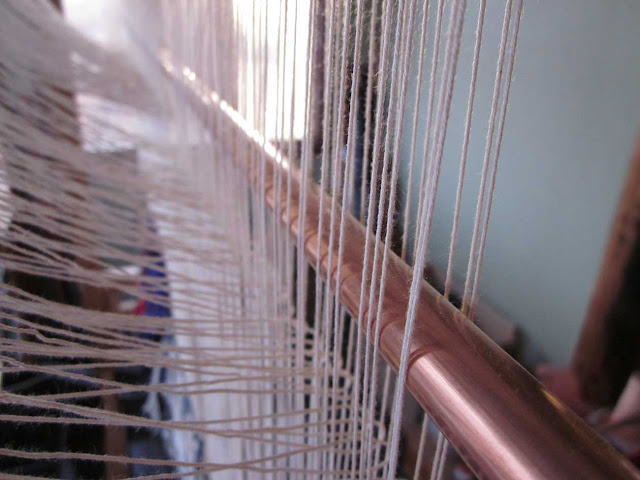It needed some cleaning up first however.
The linen warp that my grandmother had last put on the loom was still rolled on the top beam. I loved the curtain of linen it made when I pulled it down... but eventually I had to cut it off.
But not before examining how it was warped!
Clearly the loops from the cross end of the warp were at the top indicating to me that a warping board was the best way to warp this loom as opposed to some modified Navajo warping technique. As I knew Tommye Scanlin used to have a loom just like this, I consulted her for advice and she was exceedingly helpful.
I found when I unwound the old warp that water had dripped onto the top beam at some point when this warp was sitting in my grandmother's dining room waiting for a Maurice Sendak tapestry (see blog post HERE) to be woven and the two iron bars were rusted. Upon the trusty advice of my Uncle Carl, I used plain old vinegar to get the rust off the bars. I made a sort of tub with plastic sheeting and the widest crack in our back deck. It worked perfectly and only took a couple cups of vinegar. After a little scrubbing with steel wool, I had perfectly clean bars again.

There was also an issue with mold on the apron. The new version of this loom which LeClerc still makes doesn't have the canvas apron. The rod attaches directly to the beam in a slot. But this loom is an old one and the apron molded where it was wet. I opted, in this dry climate, to wait to replace it and rolled the mold right back up. I will need to replace the apron sometime soon.
I wound a warp on my warping board. Here are the warp sections hanging ready to be put through the reed.
I then threaded each loop into every other dent in an 8 dent reed (warping for 8 e.p.i.). I held the reed vertically with two clamps as I did this and slid the loops onto the bar which would hold the warp loops at the top of the loom tied to the bar that goes through the apron rod.
The entire warp was put through the reed. Unfortunately I don't currently own a 60 inch 8 dent reed and ended up using two shorter reeds to accomplish this. Because this piece has several sections, the break between the reeds didn't matter. If I was doing a piece without sections, this would not have worked.
With Emily's help, I tied the reed onto the frame, leash sticks below.
The warp was slowly rolled around the top beam and then tied at the bottom like you would a floor loom... ready to weave.
 |
| My grandmother loved to mark things and much of my weaving equipment like these leash sticks are covered with her writing. |
Another helpful resource for warping and for this project was Kathe Todd-Hooker's warping book, So Warped. It is available from her business, Fine Fiber Press. She specifically mentions a wide variety of looms and how to warp them and I recommend all tapestry weavers, especially ones like me who like to play with a wide variety of looms, have this book on their shelves.
 |
| One of my favorite bumper stickers, also from Kathe Todd-Hooker |
After the warp is on, you still have to tie leashes. This loom comes with a 1 1/2 inch leash bar which has adjustable height via chains on each side of the loom.
The leashes are tied one at a time to pull forward the second shed. I learned this method of tying leashes from Archie Brennan and Susan Martin Maffei in their tapestry course, Woven Tapestry Techniques. I have never tied leashes like this before as I usually use a loom with harnesses and treadles. Archie's description in his DVD course is helpful and clear.
I used a long copper bar to hold the open shed in place. The leashes are used to pull the back threads forward to make the other shed.
And the loom is tied up, the tension extremely even if I do say so myself!
Now all that remains is to turn this:
into a finished work of art.






















Rebecca: What a fascinating family you come from...lucky you. Wish I knew your grandma...she sure is talented. What a thrill it must be for your family to see you carry on the weaving traditions.
ReplyDeleteRebecca,
ReplyDeleteFantastic tutorial about warping up the Gobelin style LeClerc!!!!!!! I know you'll just love weaving on it. The fact that it has family ties makes it even more special.
I'm looking forward to following your first piece on this wonderful tool.
Rebecca, I have a Gobelin style leclerc loom too. I love your description of how to set it up, very clear. I'm glad you recommended Kathe's book So Warped , it was very helpful. Enjoy your new/ old loom. The family ties will make it extra special. I have one from my great aunt, I always think of her when I weave on that loom!
ReplyDeleteThank you Rebecca for sharing in detail this process. I am in the process of starting to warp a large tapestry loom that belonged to Tamara Jaworska and I am quite freaked out about making a mistake in the process. i used to have these looms years ago and was familiarized to warp them often. Now, I will start again with this big loom and reading your blog made me have more confidence and courage. Thank you. Will post my warping day as well sometime soon. All the best. Ixchel
ReplyDeleteGreat job! I'm glad you mentioned the leashes, as I am in the middle of warping my Glimakra Gobelin style loom, and need new leashes. I have Archie and Susan's DVD, so I will take a look at their method. Looks like it would be simpler and more effective than the way I invented myself.
ReplyDeleteThank you all for your kind comments about my book and the bumper sticker. I love the look on peoples faces when they see the so warped and tapestry weavers are warped. I have been behind in my blog reading. SO it was a very nice surprise. Your loom looks great and how special it's history is.
ReplyDeleteWell now that you have it all warped up how do you like weaving on the LeClerc Gobelin Loom? I need a bigger upright loom and I'm trying to decide if I want to purchase a loom or built a scaffold loom. This loom is still on the market so it would nice to know what you think about it.
ReplyDeleteThanks Dee
Dee, I like the LeClerc fine. I think it is a very good loom. It is well made and has great tensioning. I don't have the shedding device which I think would be even better. I am so used to weaving on a horiontal loom that this loom is challenging for me. I feel like it is so much slower and that is probably just that my motor skills are adjusted to the floor loom and not this one yet. The leashes are slower and beating with a hand beater really slows me down. But if you like weaving on an upright loom, I think this one is very solid. If I could choose any upright loom though, I'd choose one with a shedding device of some kind that is controlled with your feet. Just my two cents! Each weaver likes something different.
ReplyDelete